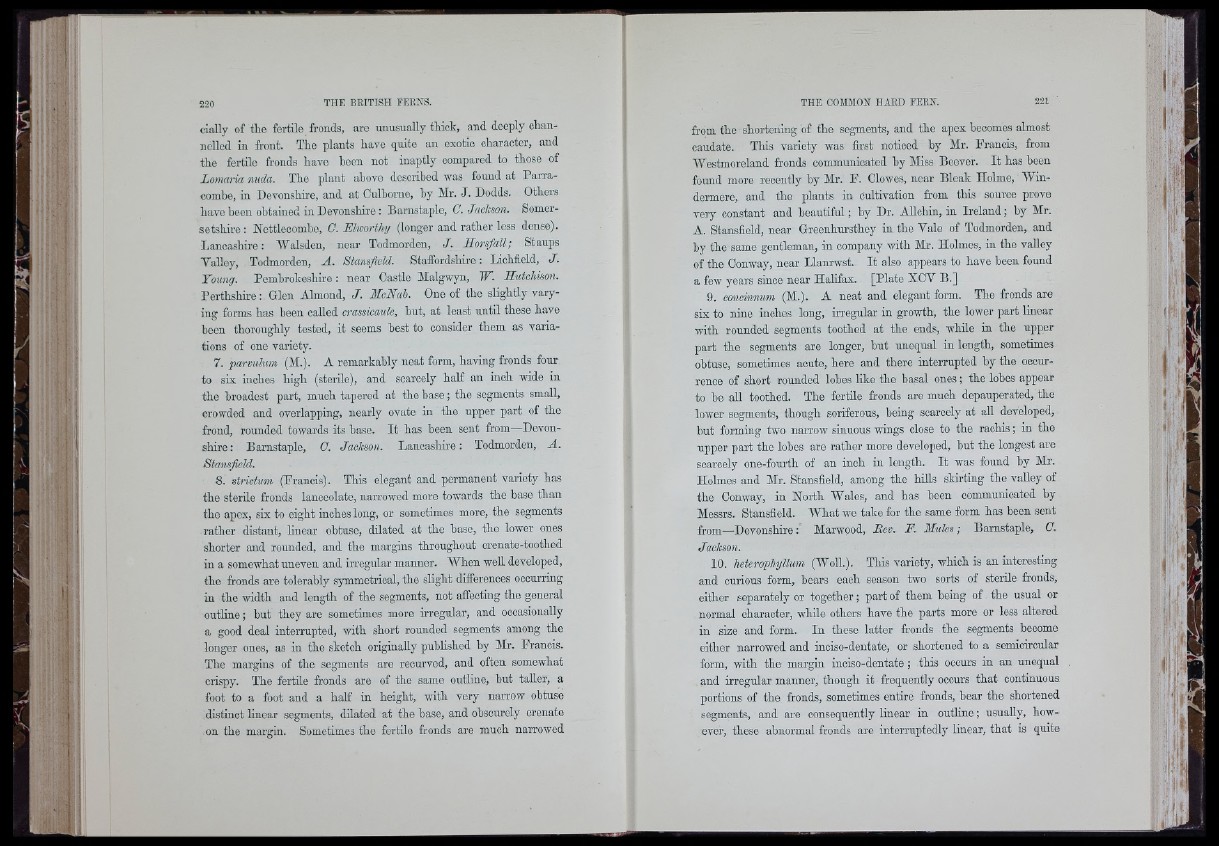
'F
. í '■
v
M u »■ I"
; ::ii
i .
■fi.
s;.
ÍM
■ n '
.i-l :
■.: r :
.1 ,
•if'
il' ,
’y :
■iit
cially of the fertile fronds, are unusually thick, and deeply ohan-
nollod in front. Tho plants havo quite an exotic character, and
tho fertile fronds havo been not inaptly compared to those of
Lomaría nuda. Tho plant above described was found at Parra-
combe, in Devonshire, and at Culborne, by Mr. J . Dodds. Others
havo been obtained in Devonshire: Barnstaple, C. Jackson. Somor-
sotshiro: Nettlecombe, C. Elworthy (longer and rather less dense).
Lancashire: Walsden, near Todmorden, J. HorsfaU; Staups
Valley, Todmorden, A . Stansfield. Staffordshire: Lichfield, J.
Young. Pembrokeshire: near Castle Malgwyn, IFi Hutchison.
Perthshire: Glen Almond, J. McNab. One of the slightly varying
forms has been called crassicaule, hut, at least until these have
been thoroughly tested, it seems best to consider them as variations
of one variety.
7. parvidum (M.). A remarkably neat form, having fronds four
to six inches high (sterile), and scarcely half an inch wide in
the broadest part, much tapered at the base; tho segments small,
crowded and overlapping, nearly ovate in tho upper part of tho
frond, rounded towards its base. It has boon sent from—Devonshire:
Barnstaple, C. Jackson. Lancashire: Todmorden, A.
Stansfield.
8. strictum (Francis). This elegant and permanent variety has
the sterile fronds lanceolate, narrowed moro towards the base than
the apex, six to eight inches long, or sometimes more, the segments
rather distant, linear obtuse, dilated at the base, tho lower ones
shorter and rounded, and the margins throughout crenate-toothed
in a somewhat uneven and irregular manner. When woll developed,
the fronds are tolerably symmetrical, the slight differences ooourring
in the width and length of the segments, not affecting the general
outline; hut they are sometimes more irregular, and occasionally
a good deal interrupted, with short rounded segments among the
longer ones, as in the sketch originally published by Mr. Francis.
The margins of the segments are recurved, and often somewhat
crispy. The fertile fronds are of the same outline, bnt taller, a
foot to a foot and a haK in height, with very narrow obtuse
distmot linear segments, dilated at the base, and obscurely crenate
on the margin. Sometimes tho fertile fronds are much narrowed
from the shortening of the segments, and the apex becomes almost
caudate. This variety was first noticed by Mr. Francis, from
Westmoreland fronds communicated by Miss Beever. It has been
found more recently by Mr. F. Clowes, near Bleak Holme, Windermere,
and the plants in cultivation from this source prove
very constant and beautiful; by Dr. Allchin, in Ireland; by Mr.
A. Stansfield, near Greenhursthoy in the Vale of Todmorden, and
by the same gentleman, in company with Mr. Holmes, in the valley
of the Conway, near Llanrwst. It also appears to have been found
a few years since near Haltfax. [Plate XCV B.]
9. concinnum (M.). A neat and elegant form. The fronds are
six to nine inches long, irregular in growth, the lower part linear
with rounded segments toothed at the ends, while in the upper
part the segments are longer, but unequal in length, sometimes
obtuse, sometimes acute, here and there interrupted by the occurrence
of short rounded lobes like tbe basal ones; the lobes appear
to bo aU toothed. The fertile fronds are much depauperated, the
lower segments, though soriferous, being scarcely at all developed,
but forming two narrow sinuous wings close to the raohis; in the
upper part the lobes are rather more developed, hut the longest are
soaroely one-foui’th of an inch in length. It was found by Mr.
Holmes and Mr. Stansfield, among tho hills skirting the vaUey of
the Conway, in North Wales, and has been communicated by
Messrs. Stansfiold. What wo take for the same form has been sent
from—Devonshire: Marwood, Rev. F. Mules; Barnstaple, C.
Jickson.
10. heterophyllum (Woll.). This variety, which is an interesting
and curious form, bears each season two sorts of sterile fronds,
either separately or together; part of them heing of the usual or
normal character, while others have the parts more or less altered
in size and form. In these latter fronds the segments become
either narrowed and inoiso-dentate, or shortened to a semicircular
form, with the margin inoiso-dentate ; this occurs in an unequal
and irregular manner, though it frequently occurs that continuous
portions of the fronds, sometimes entire fronds, hear the shortened
segments, and are consequently linear in outline; usuaUy, however,
these abnormal fronds are interruptedly linear, that is quite
* 'i
I
ll
;i I .
Jill
U á